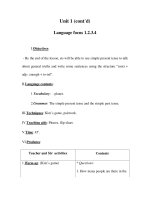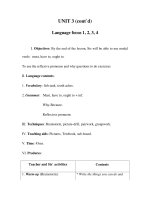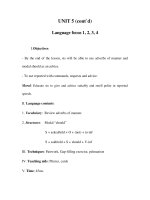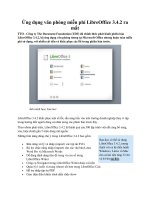3 4 2 fastest, longest, biggest, lightest (science)
Bạn đang xem bản rút gọn của tài liệu. Xem và tải ngay bản đầy đủ của tài liệu tại đây (4.86 MB, 14 trang )
Suggested levels for Guided Reading, DRA,™
Lexile,® and Reading Recovery™ are provided
in the Pearson Scott Foresman Leveling Guide.
Fastest,
Longest,
Biggest,
Lightest
~ The Guinness World Records Story ~
Genre
Expository
nonfiction
Comprehension
Skills and Strategy
• Compare and
Contrast
• Author’s Purpose
• Ask Questions
Text Features
• Map
• Caption
• Glossary
Scott Foresman Reading Street 3.4.2
ISBN 0-328-13372-8
ì<(sk$m)=bd hch< +^-Ä-U-Ä-U
by Kirsten Anderson
illustrated by Gary Krejca
Reader
Response
Fastest,
Longest,
Biggest, Lightest
1. Use a Venn diagram to compare and
contrast the bird egg records written
about in the book.
~ The Guinness World Records Story ~
Ostrich
Canary
2. Write two questions you had as you read
the book. Were your questions answered?
Anderson
3. What wordbyisKirsten
contained
in the word
illustrated
by
Gary
superlative? How does theKrejca
word help you
understand what superlative means?
4. Using an illustration in the book, find the
exact weight of the heaviest hailstone
ever found.
Editorial Offices: Glenview, Illinois • Parsippany, New Jersey • New York, New York
Sales Offices: Needham, Massachusetts • Duluth, Georgia • Glenview, Illinois
Coppell, Texas • Ontario, California • Mesa, Arizona
How large was the biggest spider ever
found? What is the fastest-swimming fish
in the world? How light was the world’s
lightest bird egg? How heavy was the
world’s heaviest bird egg? How many
inches long was the largest corncob ever
grown? And where in the world was the
coldest temperature recorded?
The book Guinness World Records
contains the answers to these questions.
Published each year, this book is a
compendium of trivia. Trivia are fun and
amusing facts. A compendium gives a lot
of information in a small amount of space.
Every effort has been made to secure permission and provide appropriate credit for
photographic material. The publisher deeply regrets any omission and pledges to
correct errors called to its attention in subsequent editions.
Unless otherwise acknowledged, all photographs are the property of Scott Foresman,
a division of Pearson Education.
Photo locators denoted as follows: Top (T), Center (C), Bottom (B), Left (L), Right (R),
Background (Bkgd)
Illustrations by Gary Krejca
Photograph 21 Corbis
ISBN: 0-328-13372-8
Copyright © Pearson Education, Inc.
All Rights Reserved. Printed in the United States of America. This publication is
protected by Copyright, and permission should be obtained from the publisher
prior to any prohibited reproduction, storage in a retrieval system, or transmission
in any form by any means, electronic, mechanical, photocopying, recording, or
likewise. For information regarding permission(s), write to: Permissions Department,
Scott Foresman, 1900 East Lake Avenue, Glenview, Illinois 60025.
2 3 4 5 6 7 8 9 10 V0G1 14 13 12 11 10 09 08 07 06 05
3
The trivia found in the Guinness World
Records compendium are the kind that are
superlative. Things that are superlative are
the most, or -est, of anything. So the book
contains trivia about the largest, smallest,
shortest, and tallest of anything and
everything in the world.
What about the huge spider that we
first asked about? According to the book,
the biggest spider ever was found in 1965.
It measured eleven inches across. That’s the
size of a large frying pan!
And what about the world’s fastest
fish? The book says that the cosmopolitan
sailfish has been measured at speeds of 68
miles per hour. A fish that fast can keep up
with a car on a highway!
Keep reading to find the answers to
the rest of the questions on page 3, as
well as many other interesting facts about
Guinness World Records.
4
5
What about the
lightest bird egg ever?
A canary egg weighed
0.0009 ounces. And the
heaviest bird egg ever?
An ostrich egg tipped the scales at five
pounds, two ounces. That means the
heaviest bird egg was almost six thousand
times heavier than the lightest!
Are you curious to know how many
inches long that corncob was? Guinness
World Records says it was 36.25 inches.
That’s more than three feet!
Finally, just how cold was the coldest
temperature ever? The book says it hit -128
degrees Fahrenheit in Antarctica in July
1983. That’s 188
degrees below
Earth’s average
temperature
of 60 degrees
Fahrenheit!
6
We’ve answered all of the questions
from page 3, but there’s another question
that needs to be asked. The question is:
How and when was the first Guinness
World Records put together?
The year was 1951. Sir Hugh Beaver
was visiting some friends, and they argued
about a question. The question was: Which
bird can fly faster, the golden plover or the
grouse? Some said the grouse was faster,
and others said the golden plover was
faster, but no one knew for sure!
Sir Hugh tried to find out. He searched
libraries for the answer, but not one of the
books that he read was of any help.
7
Sir Hugh was amazed that not a
single book had the answer! He thought
more about what had happened, and he
thought of how much people liked to
argue over trivia.
It was then that Sir Hugh had his great
idea. He thought it would be wonderful
if someone would write a book that listed
answers to trivia questions!
Sir Hugh worked for the Arthur
Guinness Company, and he told the
company about his idea. The company
liked Sir Hugh’s idea so much that it
agreed to pay to have the book written
and published.
8
Sir Hugh then told his idea to Norris
and Ross McWhirter, twin brothers who
were British writers and fact-checkers. Sir
Hugh asked the McWhirters to write the
book, and the McWhirters agreed!
The first Guinness World Records was
published in August 1955, and it became a
bestseller within a few months! The book
has been published every year since then.
More than 100 million copies of the book
have sold in 100 countries, and the book
has been translated, or rewritten, into
thirty-seven different languages.
9
What kinds of things make it into
each year’s book? The book is divided
into categories, such as nature, science,
and buildings. There are records about
money and movies, there are pages about
amazing humans and pets, and there are
also many sports records listed.
What you won’t find in Guinness World
Records are records that required people
to risk their lives. The people who write
the book do not want people to risk their
lives, and they will not write about records
that involve endangering human life.
We’ve now answered the question of
what makes it into the book, but there’s
still the question of how records get into
the book. Also, how do readers know that
the records listed are true?
There are two types of records listed in
Guinness World Records. One type is simple
facts, and simple facts are easy to check.
10
For example, the book lists India’s
Meghalaya state as the rainiest place on
Earth. Meghalaya averages thirty-nine feet
of rain each year, which is more than an
inch of rain every day!
The average yearly rainfall in
Meghalaya is something that scientists
have measured. It is a simple fact that has
been proven through observation.
11
Another simple fact involves the
heaviest hailstone ever. A piece of
hail weighing over two pounds fell in
Bangladesh in 1986. People weighed it,
and then someone reported the hailstone’s
size to Guinness World Records. Once
Guinness World Records verified, or made
certain of, the hailstone’s size, the record
was put in the book.
But what if, after another hailstorm,
other people find a hailstone that weighs
more? If they can prove to Guinness World
Records that the hailstone weighs more,
then their hailstone will set the new record
for the heaviest hailstone.
12
Many records listed in Guinness
World Records involve people who have
performed a stunt or a trick.
The record for the largest number of
tap dancers dancing at once was set in
Germany in 1998. It was set by a group
of almost seven thousand tap dancers
dancing together!
The book contains many records of that
kind. At any time, any of these records
could be broken.
For example, in 1997 a man in Sri Lanka
stood on one foot for almost seventy-seven
straight hours. But there could be someone
out there who has just finished standing
on one foot for seventy-eight straight
hours!
13
The second kind of record found in
Guinness World Records is less simple. This
kind of record lacks exact information.
For example, it is listed that families
in Egypt have kept Saluki dogs as pets for
over five thousand years. But we will never
be able to find the first family that did this.
Therefore, we will never know the exact
year a Saluki first became a family pet.
For the record to be broken, scientists
would need evidence that Salukis were
kept as pets before the people of ancient
Egypt kept them as pets.
To show how much easier it is to
verify some records than others, consider
the record of the largest dog ears ever
measured.
Mr. Jeffries, a basset hound, had his
ears measured in 2002. Each ear measured
over eleven inches from base to tip. That’s
the current record, but if there were a dog
with larger ears, a ruler could be used to
prove it.
14
15
You might wonder whose records are
put into the book, or you might even
wonder if your record could be in Guinness
World Records. The good news is that
anyone’s record can be in the book! All you
have to do is follow the proper procedure.
A procedure is the steps you take to do
something.
First, think of a record that you think
you can break or set. It may be a record
that you’ve already read about and want
to break, or you may have a totally new
idea for a record to set. Once you decide
what record you want to break or set, ask
your parents for permission to write to the
people at Guinness World Records.
16
You will need to use the official form
found on the Guinness World Records Web
site (www.guinnessworldrecords.com). The
form is also included in Guinness World
Records.
The form asks you to describe your
idea. It is important that you use as many
details as possible in your description. That
way it’s easier for Guinness World Records
to understand what you have in mind.
For example, you might want to
build the world’s biggest snowman. You
should explain on the form how big your
snowman will be and when and where you
will build it.
17
When Guinness World Records receives
your form, people there will review it. It is
important to be patient while waiting for
their reply. You may not have an answer
for about two months. That’s because
Guinness World Records receives about
sixty thousand forms every year!
When Guinness World Records writes
back to you, you will know if your idea
has been accepted. If it has been accepted,
your record, if set, may be in Guinness
World Records!
How can you improve the chances that
Guinness World Records will like your idea?
First, make sure to suggest something
that is not dangerous. As you have read,
no one at Guinness World Records wants
anyone to get hurt while attempting to set
a record.
Guinness World Records also needs to
be able to prove your record. Your idea
must be something that can be counted,
measured, or photographed. You must
show that you did what you say you did.
Finally, your idea should be something
that people will be interested in reading
about. Remember, people all over the
world read Guinness World Records!
18
19
The people at Guinness World Records
are very interested in records that can
be broken. It’s exciting when someone
attempts to break an existing record. An
existing record is one that is still standing,
or in place. People like stories of records
that are challenged.
When someone breaks a record, it is a
great accomplishment! An accomplishment
is something special that you or someone
else has done. Even if someone fails to
break a record, it’s OK because the failure
makes the record seem even more special!
20
No matter what, you shouldn’t feel
disappointed if your idea is not accepted.
Each year’s book contains over four
thousand records—so many, in fact, that
there isn’t enough space to list them all
every year. A record may be printed in the
book one year and left out the next year.
Also, you can write to Guinness World
Records as many times as you like. You may
have many different ideas, and other than
the postage stamp, it doesn’t cost anything
to send in an idea. Who knows? One of
your ideas may lead to a record printed in
Guinness World Records!
Kenny G played
the longest note
in music history
(45 minutes and
47 seconds) on his
saxophone.
21
Now Try This
Set Your Record!
Are you ready to set a personal record?
A personal record is set by doing the best
that you can do in any one activity. Your
personal record may even be a step toward
a bigger record—maybe a world record!
Here’s how to set your personal record.
Choose an activity. It could be
something from a sport, such as the
number of successful free throws made in
a row playing basketball.
You may set a goal to be accomplished
over a long period of time. For example,
you might read as many books as you can
within a month or a year. There are many
things you can try!
22
to Do It!
w
o
H
s
’
e
r
He
Make a journal to keep track of your
effort to set your record. Label a page in
your journal Personal Record One. Divide
the page into three columns.
In column one, list the steps you plan to
take to set the record. You could include
the amount of time you will practice or
work at setting your record. You could
write about the steps you will take to meet
or exceed each day’s goal.
In column two, write the final goal
you wish to reach. Explain all of the
requirements you’ll need to meet in order
to set your record.
Work as hard as you can to set your
record! When you reach your goal, write
the date you set your personal record in
column three.
Then you can start all over again and
set a different personal record!
23
Glossary
accomplishment n.
something special
that someone has
done.
compendium n.
something that gives
a lot of information
in a small amount of
space.
existing adj. being
currently alive,
present, or in place.
procedure n. a way
of doing something.
Reader Response
superlative adj. the
best or most extreme
of something.
translated v.
changed or rewritten
from one language
to another.
1. Use a Venn diagram to compare and
contrast the bird egg records written
about in the book.
Ostrich
Canary
trivia n. fun and
amusing facts.
verified v. proved
that something is
true.
2. Write two questions you had as you read
the book. Were your questions answered?
3. What word is contained in the word
superlative? How does the word help you
understand what superlative means?
4. Using an illustration in the book, find the
exact weight of the heaviest hailstone
ever found.
24









